 |
||
|
||
| ||
 Today we begin examination of the most powerful 3D accelerators produced by former noname companies. As you know, such companies have the only aim in production: profit. Price-lists of such companies contain only a manufacturer of a graphics processor, a chip's name and a memory size. That is why if you see a line with the NVIDIA GeForce2 Ti, it doesn't mean that the card was made by NVIDIA. Undoubtedly, all such companies have names, but why to indicate them if it is easier to make the chip maker responsible for such a card?! However, such cards do have an attractive factor: a low price. That is why there are a lot of users out there who buy such a lottery and then cry in every forum what they think about NVIDIA... When ATI gave out production of its cards to China, it got a portion of similar comments. Such users do not understand that it's them who should be blamed that their cards have blurry images. On the contrary, the chip makers are not guilty at all because the chips are usually of high quality, while the layout and filters are not so perfect. Of course, the blame should by laid on such manufacturers. But trade companies are also guilty because they can't pass by a Chinese who sells the cards at 1/3 of the normal price and who "feels shy" to put his name on the packages. Or such traders deal with stolen defective lots. Or they got lots of cards ordered for computer assemblage and then thrown out into the "gray" market. The first case is just a lottery with quality, the second one will definitely give you problems with stability, and in the third case the frequencies can be wrong. There are also other examples. In particular, we spoke a lot about InnoVision Multimedia and Palit products. For a certain time the Inno3D/Daytona marks were equal to low quality and reduced frequencies. But if you take their normal products delivered in Retail packages which have the manufacturer's warranty (not of the trade company), you will see that they correspond to the standards of one or another class of graphics processors. Apart from faked-up products from InnoVision and Palit there are cards with lower frequencies (and slower memory) produced by these companies by request of computer assemblers. Such cards (surpluses) often get into the gray market where it is taken by energetic resellers. These of course are not retail packages; such resellers do not have an idea even about frequencies and bit capacity of the memory bus. That is why I recommend you to buy cards only from well-known manufacturers, and you should check accessories, the package and read our reviews so that you don't get a faked-up card or something like that. Palit is well known, but its products are often sold as Noname ones. When I said that Inno3D and Daytona are also guilty that their products are associated with low quality I meant that we really saw some defective TNT2/GeForce2 MX cards. Fortunately, their modern cards have much higher quality. In general, this positive tendency is typical of the whole video card market. A lot of time passed since the announcement of the GeForce4 Ti, the market gets more and more new models, and the prices keep on falling down. What's the difference from the less known companies whose products also belong to the High-End class? First of all, prices are different. At present, the market gets more and more cards which are identical to the reference ones. So, why to pay more if it's possible to buy the same thing at a lower price? Well, they are lacking for beautiful packages, CDs with games etc., but the price is lower as well. Of course, authority also plays a great role. Although ASUS is much more expensive, it has a high authority, and a lot of users will prefer to pay an arm and a leg and to get a card from ASUSTeK. But note that if you want a card of the mainstream sector, you should buy it with a complete set of accessories and from a well-known company. But on the High-End market all manufacturers are almost equal, there are no noname ones because the production costs are too high. That is why if you need a GeForce4 Ti 4600, there is no difference between ASUS and Palit, because it will be a copy of the reference card. And now let me show you the list of reviews of the GeForce4 Ti cards published on our site. Theoretical materials and reviews of video cards which concern functional properties of the NVIDIA GeForce4 Ti GPU
This list includes such cards. Today we will examine one more such card, from Palit. I think today we will see the same things we saw in February. But this review also analyzes operation of anisotropic filtering on several stands. We will see how the CPU frequency and the platform affects speed, and what a bad mistake NVIDIA has done when released cards the performance of which drops too much when anisotropy gets enabled (it was less even of the GeForce3 Ti cards). CardThe card has an AGP x2/x4 interface, 128 MBytes DDR SDRAM located in 8 chips on both sides of the PCB.

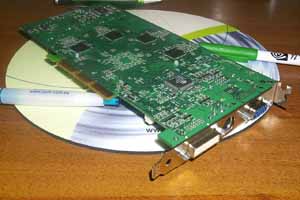
 The Samsung 2.8ns memory chips correspond to 357 (714) MHz. The memory works as 325 (650) MHz. The new BGA package and the new design allow the memory work stably at the rated frequencies even without cooling. The chip operates at rated 300 MHz. Daytona GeForce4 Ti 4600
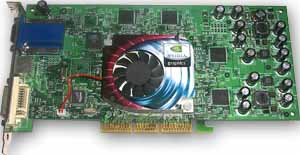
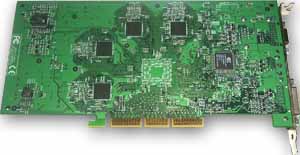 NVIDIA GeForce4 Ti 4600
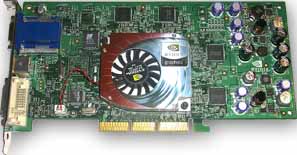
 The card obviously follows the reference design. But soon Palit will finish developing a new design of the card. Many cards based on the GeForce4 Ti differ almost only in coolers, but Palit decided to use the cooler recommended by NVIDIA.

 The cooling device is a closed box into which the fan drives air. Air flows over the chip and comes out through the channels in the heatsink. This is a very effective shape and it is used by many companies. And what is there under the heatsink?
 Here is the GPU (A2 revision). It is codenamed NV25 and produced at the end of 2001. Note that today there are cards of the A3 revision which have the official marking. The Daytona GeForce4 Ti 4600 has a Conexant codec which controls TV-out. The TV-out capabilities were already described in our base review of the GeForce4 Ti. Remember that such long cards as GeForce4 Ti 4400/4600, which have a lot of capacitors in their tail-part, can be incompatible with some mainboards, for example, with EPoX 8KHA+. For details see the MSI GF4Ti4600 review. Besides, there can be problems with i815E mainboards, for example, with the Chaintech 6OJV2. See the Creative 3D Blaster 4 Titanium 4400 review for details. Apart from the TV-out, the GeForce4 Ti Daytona GeForce4 Ti 4600 comes with VGA and DVI connectors. We have already written about the dual-monitor support and nView.
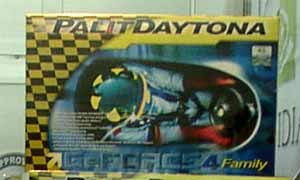 The card ships in the colorful retail package which includes:
OverclockingThe card ships with 27.50/Win9x and 27.50/WinXP drivers. The card works stably at 325/375 (750) MHz, the result is very good taking into account that the card uses the chip of the A2 stepping which is not easy to overclock. Note:
 But in this case the huge heatsink is able to
cool down the card even at such high frequencies. Test system and driversHere we examine how the accelerator's performance depends on a CPU frequency (and on a platform), that is why we used several test stands:
The test system was coupled with ViewSonic P810 (21") and ViewSonic P817 (21") monitors. In the tests we used NVIDIA's drivers of v28.32. VSync was off, S3TC was off. For the comparative analyses we used the following cards:
Test resultsThe 2D quality is excellent, no problems up to 1600x1200x85 Hz. For estimation of 3D quality we used:
The test was carried out in a 32-bit color mode with the anisotropic filtering enabled up to Level 8 for the GeForce4 and up to 16x degree for the RADEON 8500. 3D Mark2001 SEGame1 Low Details1024x768
 Earlier we saw that it was useless to install such powerful cards into relatively weak systems. But the today's tests show that when the anisotropy is enabled, the GeForce4 Ti 4600 shows decent results on the weak computers. And on powerful computers the performance drop is comparable to that when the old SuperSampling AA Level 4 gets enabled. 1280x1024
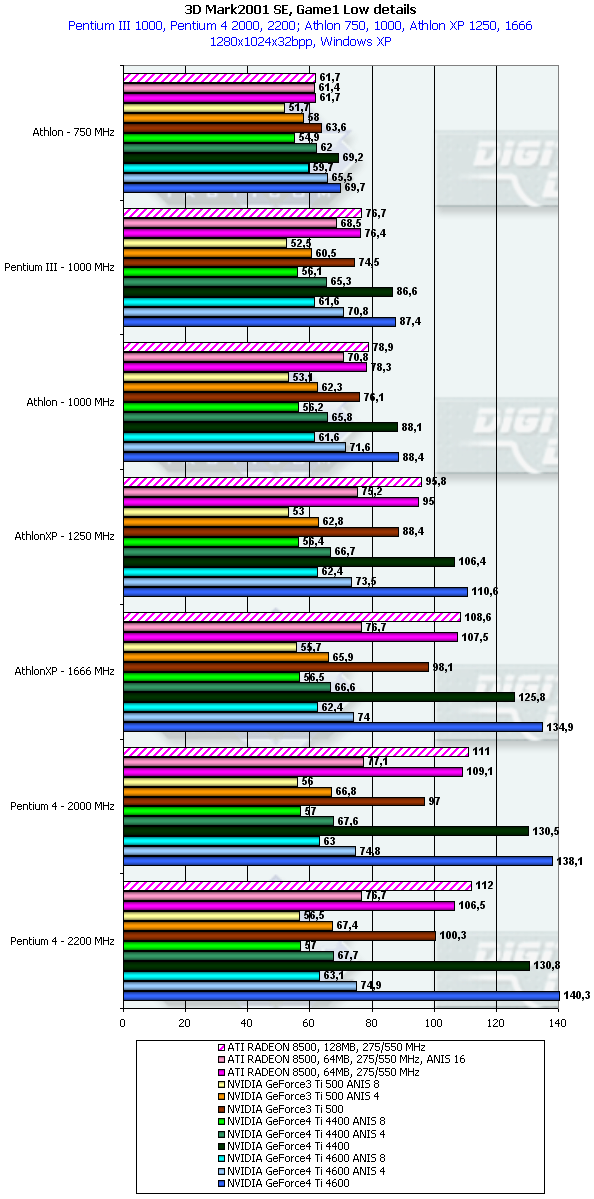 The situation is even worse. 1600x1200
 This $400 accelerator has a lower speed, when the highest quality is set, than the RADEON 8500 which costs $220! I examined anisotropy of the GeForce4 lots of times, and each time the cost of it was very high. It is strange that the cost is higher than that of the GeForce3, although the architecture didn't change much. But we can't compare directly two anisotropy realization methods - of NVIDIA and of ATI. Because in the second case we don't have true anisotropy: for some surfaces (which are at the angle over 45 degrees) the image isn't sharp. Example 1GeForce4 Ti

 RADEON 8500
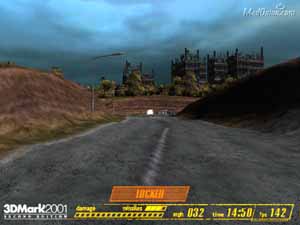
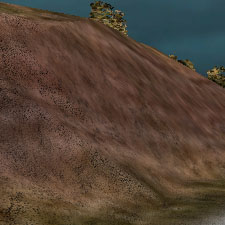 Example 2GeForce4 Ti
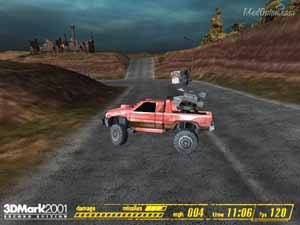
 RADEON 8500
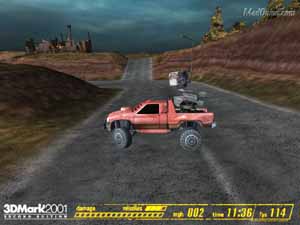
 Of course, it's difficult to notice such things. But the anisotropy quality of the GeForce4 Ti at the highest level is a little better, hence the speed decrease. Game2 Low Details1024x768
 Here the situation is a little better for the GeForce4 Ti, relatively to the GeForce3 Ti 500. As for the RADEON 8500, there is nothing to say. 1280x1024
 1600x1200
 Well, the GeForce4 Ti 4600 works worse than the Ti 500 :-( Example 1GeForce4 Ti
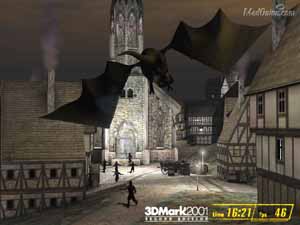
 RADEON 8500

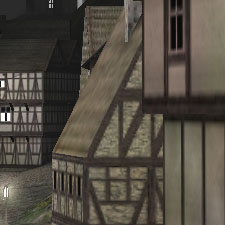 Here we can see a mistake of the anisotropy of the RADEON 8500, hence so low cost. But the performance drop of the GeForce4 Ti is too expensive for just a little better quality. We will analyze Game3 and Game4 tests in the next review of one more card on the GeForce4 Ti 4600, from Joytech. ConclusionAgain we see how strong the performance of the GeForce4 Ti drops when the anisotropy is activated. I won't come back to this issue when new drivers become available. The engineers of ATI were more practical. But there are a lot of users out there who know nothing about such filterings, and for them the GeForce4 Ti 4600 remains the fastest card for the spring 2002. The Palit's card is a successful solution as a copy of the reference-card at a lower price (some $320 for the Palit Daytona GeForce4 Ti 4600). It doesn't have utilities, games and other stuff, but it has the lowest price for such High-End solution. For more complete characteristics of video cards of this and other classes see our 3Digest. Highs:
Lows:
Write a comment below. No registration needed!
|
Platform · Video · Multimedia · Mobile · Other || About us & Privacy policy · Twitter · Facebook Copyright © Byrds Research & Publishing, Ltd., 1997–2011. All rights reserved. |